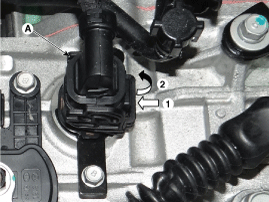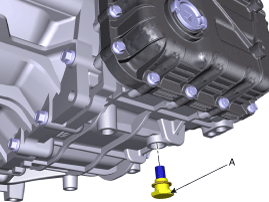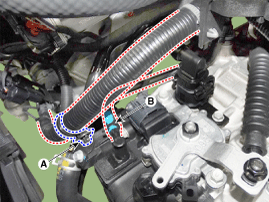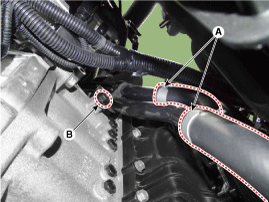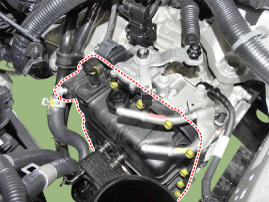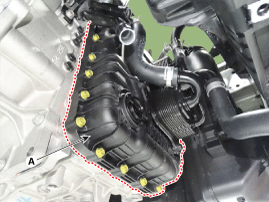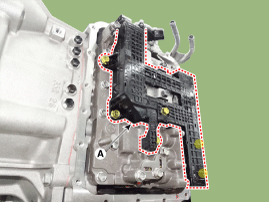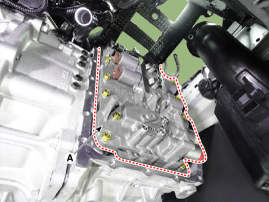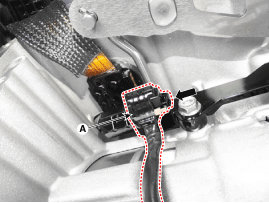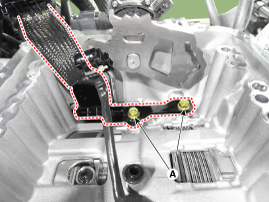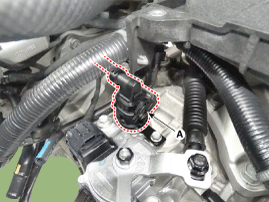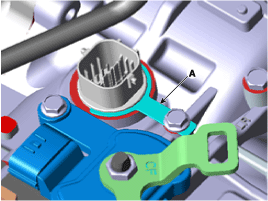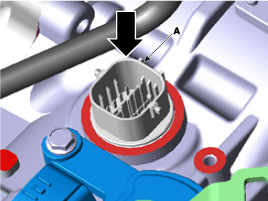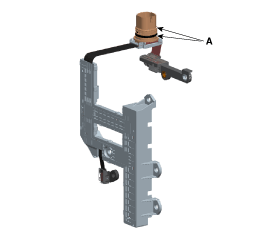Hyundai Elantra: Automatic Transaxle Control System / Transaxle Oil Temperature Sensor Repair procedures
Hyundai Elantra AD (2016-2020) Service Manual / Automatic Transaxle System / Automatic Transaxle Control System / Transaxle Oil Temperature Sensor Repair procedures
| Inspection |
| 1. |
Turn ignition switch OFF. |
| 2. |
Remove the battery and battery tray. |
| 3. |
Disconnect the solenoid valve connector (A).
|
| 4. |
Measure resistance between sensor signal terminal and sensor ground terminal. |
| 5. |
Check that the resistance is within the specification.
|
| Removal |
| 1. |
Remove the air cleaner assembly and air duct.
(Refer to Engine Mechanical System - "Air cleaner") |
| 2. |
Remove the drain plug (A) and drain the ATF totally and then reinstall the drain plug.
|
| 3. |
Remove the wiring mounting clip (A). |
| 4. |
Disconnect the air breather hose (B) from the valve body cover.
|
| 5. |
Disconnect the hose (A) after removing the automatic transaxle fluid cooler hose clamp.
|
| 6. |
Disconnect the ATF warmer hose (A). |
| 7. |
Remove the mounting bolt of the heater pipe.
|
| 8. |
Remove the valve body cover (A).
|
| 9. |
Disconnect the oil temperature sensor and solenoid valve connector (A) from the valve body.
|
| 10. |
Remove the valve body assembly (A).
|
| 11. |
Disconnect the input & output speed sensor connector (A).
|
| 12. |
Loosen the main connctor bolt (B).
|
| 13. |
Disconnect the solenoid valve connector (A).
|
| 14. |
Remove the solenoid valve connector mounting clip (A).
|
| 15. |
Remove the solenoid valve connector (A) by pushing down from the transaxle.
|
| Installation |
| 1. |
To install, reverse the removal procedure. |
| 2. |
Check fluid level, after filling the automatic transaxle with fluid.
(Refer to Hydraulic System - "Fluid") |
 Transaxle Oil Temperature Sensor Schematic Diagrams
Transaxle Oil Temperature Sensor Schematic Diagrams
Circuit Diagram
...
 Input Speed Sensor Description and Operation
Input Speed Sensor Description and Operation
Description
Input speed sensor is a vital unit that measures the rate of
rotation of the input shaft inside the transaxle and delivers the
readings to the TCM. The sensor provides critical inpu ...
Other information:
Hyundai Elantra AD (2016-2020) Service Manual: Intake Air Temperature Sensor (IATS) Specifications
Specification
Temperature [°C(°F)]Resistance (k?)-40(-40)40.93 ~ 48.35-20(-4)13.89 ~ 16.030(32)5.38 ~ 6.0910(50)3.48 ~ 3.9020(68)2.31 ~ 2.5740(104)1.08 ~ 1.2150(122)0.76 ~ 0.8560(140)0.54 ~ 0.6280(176)0.29 ~ 0.34
...
Hyundai Elantra AD (2016-2020) Service Manual: Front Door Inside Handle Repair procedures
Replacement
1.
Remove the front door trim.
(Refer to Front Door - "Front Door Trim")
2.
After loosening the mounting screws, remove the front door inside handle (A).
3.
To intall, reverse the removal procedure.
•
Make sure the door locks / unlocks and opens / ...
© 2018-2025 www.helantraad.com

